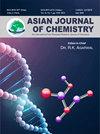Anticancer Potential of Gold doped ZnO Nanoparticles Fabricated using Root Extract of Kigelia africana (Lam.) Benth. against Lung (A549), Melanoma (A375) and Epidermoid (A431) Cancer Cells
Q4 Chemistry
引用次数: 0
Abstract
This study presents a simple, biocompatible and eco-friendly Au-doped ZnO nanoparticles were fabricated by employing root aqueous extract of Kigelia africana (Lam.) Benth. root as reducing, stabilizing and capping agent. The nanoparticles were identified by showing characteristic UV-visible wavelength maxima at 361 nm (ZnO NPs) and 569 nm (Au NPs). The nanoparticles possess polycrystalline structure with circular to oval in shape having 34 nm size that contains ~24.74 % and ~52.16 % of Au and Zn content. The FT-IR analysis confirmed the functional groups correspond to terpenoids, flavonoids and phenolics present in aqueous root extract of of Kigelia africana (Lam.) were actively participated in nanoparticles capping. The cytotoxic applicability of fabricated nanoparticles was assessed by performing MTT assay against human lung cancer (A549) cells, melanoma cancer (A375) cells and skin or epidermoid cancer (A431) cells. The nanoparticles were proved to show potential anticancer activity with IC50 concentration of 206.13 µg/mL, 152.73 µg/mL and 295.49 µg/mL against A549, A375 and A431 cell lines respectively. The IC50 concentration of nanoparticles in DPPH assay was noticed as 43.75 µg/mL, whereas 33.95 µg/mL and 81.10 µg/mL respectively noticed for standard and aqueous root extract suggest that the nanoparticles possess potential antioxidant capability. Based on findings, it was suggested that the fabricated Au-doped ZnO NPs were treated as promising biocompatible candidate that can having remarkable applicability in therapeutic applications.利用 Kigelia africana (Lam.) Benth.根提取物制备的掺金氧化锌纳米粒子对肺癌(A549)、黑色素瘤(A375)和表皮样癌(A431)细胞的抗癌潜力
本研究介绍了一种简单、生物兼容且环保的金掺杂氧化锌纳米粒子的制备方法,该制备方法采用了 Kigelia africana (Lam.) Benth.根的水提取物作为还原剂、稳定剂和封盖剂。纳米粒子在 361 纳米(ZnO NPs)和 569 纳米(Au NPs)处显示出特征性的紫外-可见光最大波长。纳米粒子具有多晶结构,形状为圆形至椭圆形,大小为 34 nm,其中金和锌的含量分别为 ~24.74 % 和 ~52.16 %。傅立叶变换红外分析证实,Kigelia africana (Lam.)水生根提取物中的萜类、黄酮类和酚类官能团积极参与了纳米颗粒的封装。通过对人肺癌(A549)细胞、黑色素瘤(A375)细胞和皮肤或表皮样癌(A431)细胞进行 MTT 试验,评估了制成的纳米颗粒的细胞毒性适用性。结果表明,纳米粒子具有潜在的抗癌活性,对 A549、A375 和 A431 细胞株的 IC50 浓度分别为 206.13 微克/毫升、152.73 微克/毫升和 295.49 微克/毫升。纳米颗粒在 DPPH 试验中的 IC50 浓度为 43.75 µg/mL,而标准提取物和根茎水提取物的 IC50 浓度分别为 33.95 µg/mL 和 81.10 µg/mL,这表明纳米颗粒具有潜在的抗氧化能力。研究结果表明,制备的掺金氧化锌纳米粒子具有良好的生物相容性,可广泛应用于治疗领域。
本文章由计算机程序翻译,如有差异,请以英文原文为准。
求助全文
约1分钟内获得全文
求助全文
来源期刊

Asian Journal of Chemistry
化学-化学综合
CiteScore
0.80
自引率
0.00%
发文量
229
审稿时长
4 months
期刊介绍:
Information not localized
 求助内容:
求助内容: 应助结果提醒方式:
应助结果提醒方式:


